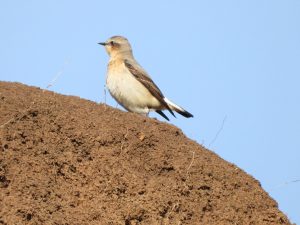News from Common Bird Monitoring Scheme in Moldova
December 9, 2022
This year, Moldova joins the International Census Plots initiative. Silvia Ursul, the scheme coordinator, summarises the country's pilot season of bird monitoring in ten plots surveyed by nine volunteers.
Introduction
During April-June 2022, the Society for Birds and Nature Protection from Moldova carried out the Common Bird Monitoring survey, which consisted of field research in ten plots of 2×2 km each. The plots were surveyed using the point count method, which consists of observing bird species for five minutes at each of the ten points randomly assigned to the fieldworker inside the 2×2 km plot.
The plots were surveyed between April 15th and June 15th by a team of nine people (one person surveyed two plots). The observers possessed average to advanced knowledge about common bird species of the Republic of Moldova and were involved in previous field research activities.
For good coverage of all bird species, each fieldworker had to survey their plot during two separate visits: one during April-May and another during May-June. Volunteers chose their plot based on how accessible and close to their home it was situated. Due to the possibilities of our team, the plots ended up being spread unevenly across the country: two plots in the North region, three in the Center and five in the South.
Nice results
We gathered good field data about breeding species from ten different plots. In total, during the 2022 CBM scheme, we counted 2,718 bird individuals and 96 bird species. During the first round of visits (from April 15th to May 15th), there were 1,186 bird individuals and 82 species. During the second round of visits (from May 16th to June 15th), there were 1,532 bird individuals and 83 species.
The most common species encountered during the CBM scheme (present in all the monitoring plots) were:
Lanius collurio, Merops apiaster, Sturnus vulgaris, Emberiza calandra, Oriolus oriolus, Cuculus canorus, Phasianus colchicus, Corvus frugilegus, Passer montanus, Passer domesticus, Motacilla flava, Hirundo rustica, Oenanthe oenanthe, Streptopelia turtur, Streptopelia decaocto, Parus major, Galerida cristata and many others.
There were also several rare (or not that common) species encountered during the field study:
Milvus migrans, Locustella luscinioides, Tadorna ferruginea, Ciconia nigra, Himantopus himantopus, Calandrella brachydactyla, Hippolais icterina, Caprimulgus europaeus, Crex crex, Falco tinnunculus, Poecile montanus, Athene noctua.
The data regarding the common bird species encountered in all ten plots was uploaded via the Ornitodata app, provided by the Romanian Ornithological Society. The Romanian team developed the app to serve their own common bird monitoring scheme, which is very similar to ours. Our team was lucky to use the app during the field visits, which allowed us to save precious time, as it provided some automation processes and made it easier to collect data in the field. Using the Ornitodata app allowed us to cover the plots faster and offered a good user experience out in the field. We are thankful to our Romanian colleagues for their help and assistance!

Northern Wheatear, a normal encounter in rocky landscapes. Photo by Olesea Lomaca
Lessons we learnt
We were very lucky to have the support of the EBBC team, mainly the „International Census plots” project team, who helped us financially and morally. We felt their sincere interest in helping us overcome financial obstacles and improve our field study research. With their financial help, we purchased new binoculars, a GPS device, and five bird guides paid the travel costs of our volunteers and organised a final meeting where we presented the results of this year’s CB survey.
The advantage of securing funds helped us stimulate our team to work with more motivation and to grasp a sense of being part of something bigger, a continental European network.
However, we struggled a bit with retaining volunteers in our team, as some emigrated abroad, searching for a summertime jobs. It is still challenging to expand our little team and co-opt new people interested in participating in next year’s survey. We need to involve potential volunteers in year-round field activities, starting from simple to more complicated, so that they would build courage and be ready for more challenges once a new breeding season comes.
Silvia Ursul, common bird monitoring scheme coordinator




